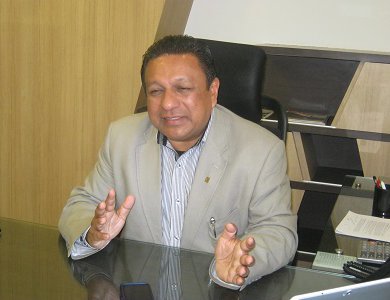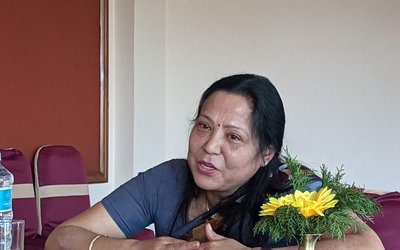
How do you look at the involvement of private sector in hydro-power?
First of all, we need to be clear as to whether hydropower is our necessity or not. Whether hydropower development is necessary or not. Food security, water security and energy security are three basic things. Thus, we have no option other than to develop these sectors. We have many other resources: coal, wood, solar, air, and bio-gas. However, they are expensive. Among the energy sources, hydropower is much cheaper than several energy sources available in the country. Along with this, our added advantage is big, with neighboring Indian and Bangladeshi markets, where there is a huge scarcity of energy round the year and water during the dry season. In this context, we need to move much faster in speed but we are yet to take off. Our pace is very slow as we have developed just 700 MW of power in one hundred years and we are happy with the revelation that Nepal will produce 1200 MW in another decade.
What do you suggest in this situation?
We need to develop over 10,000 MW of power in the coming five to six years like Bhutan did. Although Bhutan does not have its own resources and market, it will have 12,000 MW installed capacity by 2022. Since Nepal has markets as well as resources, there is the need to set a bigger target. Thanks to FNCCI’s efforts, there is almost some political consensus now on how to develop hydropower. Except some sporadic voices, there is almost no opposition against the development of hydropower. What I can say is that there is just some scale of blackmailing.
There is also a huge possibility for export of our energy. The nature of our rivers is that there is abundance of water during the summer when the demand of electricity goes high in India and Bangladesh. Nepal’s situation is that Nepal does not have adequate energy in winter and surplus in summer. Nepal would have surplus electricity by 2017. As Nepal has a huge market in South, Nepal can import the electricity when there is scarcity and export during the surplus production. The recently signed Power Trading Agreement (PTA) opens the Indian market. This way Nepal is a ready place waiting for the investment in hydro-electric sector. Who are the investors? First priority should be given to the private sector.
If so, why is the investment not coming?
Frankly speaking, Nepal government is the No. 1 enemy of investment. The government employees, Nepal government’s agencies whether they are Ministries of Energy, Environment or Forest or constitutional bodies like Commission for the Investigation of Abuse of Authority are emerging as enemies of hydropower development. Due to all the procedural complications and administrative red tapes, the private sector is unable to contribute in this sector as per its wishes. If Nepal wants to develop its hydropower, there is the need to have a mechanism to welcome private investor through red carpet. It is unfortunate to say that that kind of thing is not at in the government's priority. For example, if you go to the government with one problem, it will return you with four more problems. When private sector’s license did not move due to Ministry of Energy’s negligence, CIAA ordered these be scrapped. Kabeli hydropower is a good example. When the World Bank agreed to provide the much-needed loan, CIAA ordered scrapping the license of the project and Ministry of Energy scrapped the license. Now Ministry of Forest and Soil Conservation is the No. 1 enemy against hydropower development. A hydropower company which can produce the energy equivalent to over a million tree energy is not allowed to clear 1000 trees. A hydropower developer needs to purchase the land enough to plant 25 times the trees than it clear for the power project and one has to make six feet high to get the license. Is not it funny? Given such a scenario, how can you believe that Nepal government is eager to develop hydropower? The government does not want hydropower to develop.
What about Prime Minister Sushi Koirala who has been preaching for the development of hydropower at any cost?
It is just his rhetoric. Actually, the prime minister is sleeping and doing nothing to clear the hurdles. The prime minister is boasting for his success to hold the SAARC summit. In reality, nothing is happening. Prime Minister Koirala must understand that Nepal cannot make progress without hydropower development. Only through the hydropower development, we can reduce the huge trade deficit with India and solve crisis of Indian currency, foreign interference, rural employment and scarcity of LPG.
How do you see the recent Power Development Agreement signed by Nepal Investment Board and India’s two major companies? Don’t you think these two agreements bring any change in the current state of Foreign Direct Investment?
Of course, signing the two PDAs is a good beginning. However, the government’s present power development policy itself is wrong. For instance, the government is still involved in constructing the hydropower project. Despite huge cost, the government is involved in the construction of smaller projects like Chameliya 36 MW, Trishuli III A 60 MW and Kulekhani III 12MW. The government should not get involved in the project below 100 MW and private developers should be given to construct such projects. In case of weak private sector, there is no option for government other than to get involved in the construction of project. There was a time when the government needed to be involved in the banking sector and industrial sector. The situation has changed now. If private sector is capable, the role of government should be that of a facilitator or regulator. It is good to see the government’s involvement in 457 MW Upper Tamakoshi. There is no sense for the government to get involved in the projects below 100 MW. The private sector should be given opportunity to build smaller projects. The government does not have decision making capacity and it is more corrupt. This is the reason the power project constructed by the government is much more expensive than the power project developed by the private sector. Private sector has not constructed the project per kilowatt less than 300 million. However, the cost of government owned project is over 300 million. We need to have clear policy for hydropower development. Government should go for above 100 MW and foreign investor should be given the mega projects or projects above 1000 MW. If the government does not change its mentality and policy, nobody will come to invest in Nepal. Private sector is for making profits and it does not go to areas where it will lose money. In banking sector, private entrepreneurs are making profit.
The government needs to copy the success of the private sector in hydropower. Private sector gives the key players in banking, remittances, airlines and tourism sector, where the government makes little investment. This needs to be replicated in the hydropower sector as well.
How do you see the state of transmission line?
Transmission line falls under the purview of the government. There is no country in the world where transmission line is owned by private sector and it is the government's job to build transmission line up to the power house. Since the transmission lines involve so many complications including the land acquisition and resettlement of thousands of people, private sector cannot do it. The government needs to invest in transmission line with a vision for another fifty years. There is no sense for private sector to invest in transmission line. I am dead against private sector investment in transmission.
How do you see the recent controversy in hydropower lines?
The government has to take all the responsibility for the present state. With the introduction of open policy 1990, the government issued a number of licenses with just Rs.1800.00 deposit. During the early days, only a few people applied for license in Department of Electricity Development. After the success of Chilime and privatization of Butwal Power Company, private sector jumped in to the hydropower sector. The government has to stop issuing the license when the volume of application seekers increases. Had the government taken the right decision, the present situation would not have come. In other countries, the government makes studies and designs the projects and only after they call for private sector to obtain licenses. Had the government chosen the right steps, the government would generate billions of rupees as revenue.
When will your own project complete?
We will complete our project in 30 months. Private sector is ready to get involved in hydro power development. Even in the present uncertain political scenario, private sector has already shown willingness to invest over 4 billon dollars in power sector. There is still a lot of money. Since the government issued the license of Upper Karnali in 2007 but we signed PDA in 2014. Sutlaj too has to wait 7 years to sign PDA for Arun III. Had the project started construction seven years ago, the project would have started generation of electricity now. I have started the construction of my own project Modi in 2006 but the tariff was not viable and we had to wait for almost 7 years. The government needs to change the mentality. The government needs to bring clear policy addressing the present controversy of local share issue, transmission line and tariff. It is unfortunate to say that the government is not serious on the development of hydropower. Even the government failed to bring New Nepal Electricity Act which it tabled in 2006. The government is unable to bring an act in nine years. With initial cost of 36 billion, the Upper Tamakosi will cross Rs. 50 billon as it is going to be delayed for almost one and half year. This is still cheaper. What happens if similar things emerge in projects? There is the need of fast track approach.
Instead of making expensive projects with per unit charge Rs.14, it will be better for Nepal to import electricity at Rs. 4 per unit from India. I don’t think there is any nationalist issue involved in importing cheaper energy. Importing cheaper electricity from India is in Nepal’s own interest.
Do you see any positive things in power sector?
It is good to say that Nepal’s current load shedding problems will be easing next year. In my recent visit to India, I had the opportunity to meet power minister Piush Goel and Rail Way minister Suresh Prabhu. Indian government is very much positive on Nepal’s issues. Power minister Goel is ready to provide electricity, as much as possible.
- FOREIGN EXCHANGE: Largest Deposit
- Jul 22, 2024
- IMF: Approval Of SDR
- Jul 22, 2024
- NEPAL-KOREA RELATIONS: Fifty-Years Of Warm Relations
- May 31, 2024
- NEPAL-BRITAIN: Centenary Celebration
- May 31, 2024
- POLITCS: Forming New Alliances
- May 27, 2024
















